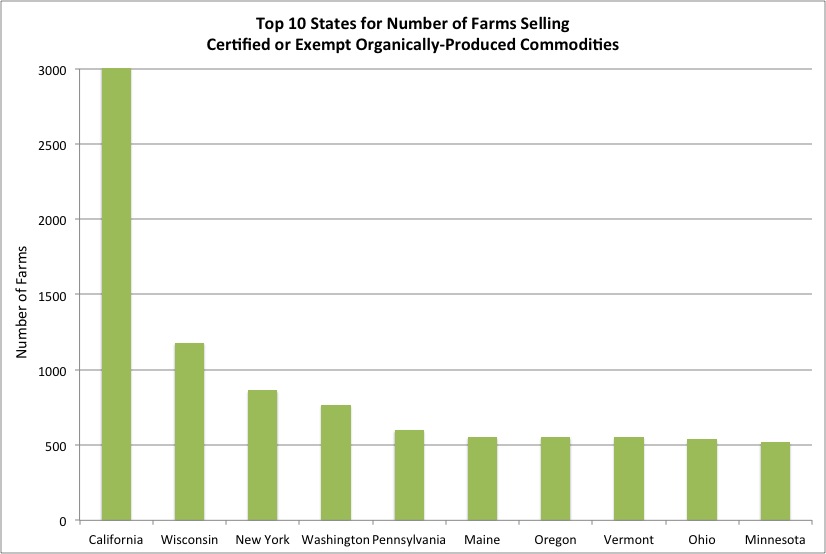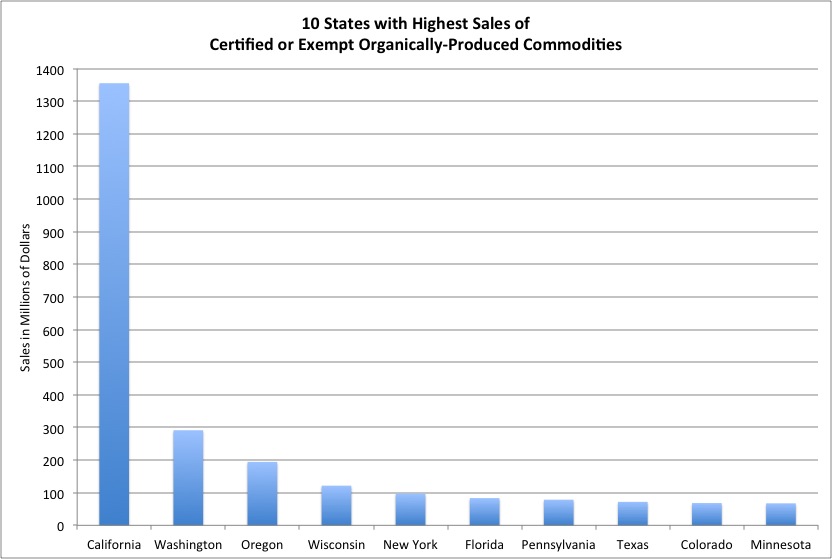On May 2, USDA released data from the 2012 Census of Agriculture. The Census of Agriculture has been conducted since 1840 and currently is collected once every five years. This is the second in a series of drill down posts, looking at particular themes from the Census that relate to local and regionally produced food and organic agriculture.
To view the other posts in this series, check out the following links:
- Minority and Women Farmers Drilldown
- Beginning Farmers Drilldown
- Conservation and Energy Drilldown
- Census Overview
Organic
Organic Farming Numbers
As part of the Census, USDA reports on the number of farms and farmland acreage in organic production across the country. According to the 2012 Census, there were 16,525 farms classified as organic (either certified or exempt), or roughly 0.7 percent of all farms in the U.S (2,109,303).
While there have been reports and media comparing the 2007 Census data on organic agriculture with that from the 2012 Census, the major differences between two on the definition of “organic farms” cautions against any such comparisons, as explained below.
Organic Survey
In 2008, NASS completed the first ever comprehensive Organic Production Survey as a follow-on to the 2007 Census of Agriculture, in order to collect additional information on organic farms – including specific production challenges, productions costs, availability of organic inputs, participation in federal crop insurance programs, and how organic producers are marketing their products (including selling through local and regional food systems). This survey provided a wealth of information on the economic health and growth potential of the organic industry as a whole, and has allowed policymakers, farmers, organic advocates, and consumers to better understand the structure of organic farming in the U.S.
Unfortunately, much of the data collected on organic farmers in the 2007 Census is not comparable to similar data collected in the 2012 Census, due to how “organic” is defined (or not defined) in each survey. Both the 2012 Census and the 2008 Organic Production Survey define “organic” in the same way – commodities produced according to USDA National Organic Program standards. However, these two survey instruments used slightly different methodology and although data from these two surveys provide a stronger comparison than between the 2012 and 2007 Census, the comparison is not as strong as other data consistently collected in the Census.
NSAC and our allies in the organic sector have therefore been urging NASS to conduct a second Organic Production Survey as a follow-on survey to the 2012 Census – which would allow reliable comparison between data from the 2008 Organic Production Survey and would show the most complete and accurate picture of what is happening within the organic sector. It would answer the question of whether the number of certified organic farms is actually increasing or decreasing, whether production costs are keeping pace with organic price premiums, and how long farmland is staying in organic production.
NASS is currently proposing a more limited Organic Survey for 2014, in partnership with the Risk Management Agency (RMA), to collect data on organic production specifically to allow RMA to develop organic price elections for the federal crop insurance program. While NSAC is supportive of these efforts, we nonetheless believe that NASS must also conduct a more comprehensive Organic Production Survey as a follow-on to the 2012 Census to provide defensible trend data on the organic sector.
Leading Organic Farming States in 2012
Looking at just the 2012 Census itself, the highest concentration of organic farms is in the West (especially in California), with the Midwest and Northeast coming in second, as shown in this chart of the top ten states.
For the most part, organic sales are concentrated in most of the same states with the greatest number of organic farms – with California and the Pacific Northwest leading the nation. However, Florida, Texas, and Colorado replace Ohio, Vermont, and Maine on the list of the top 10 states with the highest value of sales of certified or exempt organic commodities – due to the large concentration of high value crops produced in those states.
Participation in Cost-Share Programs
Unsurprisingly, all of the top ten states in either the number of organic farms or organic sales had strong rates of participation in either one or both of the USDA organic cost share certification programs: the National Organic Certification Cost Share Program (NOCCSP) or the Agricultural Management Assistance (AMA) Organic Certification Cost-Share Program. These programs help defray the costs of organic certification for producers and handlers of organic products. Producers and handlers can receive up to 75 percent of their annual certification costs up to a maximum payment of $750 per year. The top ten states for number of organic farms and total organic sales also accounted for 70 percent or more of the funds allocated for NOCCSP or AMA.
Because annual organic certification costs can be prohibitive, particularly for small and mid-sized farmers, the assistance provided through AMA and NOCCSP are essential in helping farmers become organic operations and maintain their organic status. The 2014 Farm Bill provides $11.5 million annually in mandatory funding for NOCCSP, more than double the just over $5 million available annually for the program from the 2008 Farm Bill. NSAC advocated restoring and increasing funding for NOCCSP in the new Farm Bill.
Organic Farmer Demographics
Organic farms display more gender and age diversity than that seen on non-organic farms, and tend to be operated by younger farmers. According to the 2012 Census, women make up about 16 percent of the 1,821,039 primary farm operators in the United States and 18 percent of the 16,525 primary farm operators for organic farms. Additionally, while the average age of primary farm operators as a whole is 58 years old, the average age of primary organic farm operators is 53 years old.
Local Food
Direct to Consumer Agriculture
Sales of agricultural products through direct-to-consumer outlets such as farmers markets and roadside stands have grown rapidly over the last decade. In the 2002 Census, direct-to-consumer sales equaled $812 million, climbing to $1.3 billion in the 2012 Census, an increase of 60 percent. Additionally, the number of farms selling directly to consumers has increased from 116,733 in 2002 to 144,530 in 2012. When compared with the 2007 Census, the current Census shows an increase of 8 percent for the number of farms selling directly to consumers and 5 percent for the sales in dollars of directly marketed agricultural products.
Direct to Retail and Value-Added
For the first time, the 2012 Census provides a more detailed glimpse into local food marketing, providing categories such as direct-to-retail marketing, production and sales of value-added commodities, and marketing through community supported agriculture (CSAs).
For CSAs and direct-to-retailer marketing, many of the top 10 states, such as California, Wisconsin, New York, Washington, and Pennsylvania, were the same ones that were among the top 10 states for the number of organic farms or organic sales. In the direct-to-retailer category, however, southern states also make a strong showing, with Texas, North Carolina and Virginia making the top 10 list, while Texas and North Carolina round out the top three states after California for CSA marketing. In the production and sales of value-added commodities, the southern states dominate, with Texas, Kentucky, Oklahoma, Tennessee, and Virginia among the top ten states.
The Importance of Data: Local Data Initiative and Organic Data Initiative
All farmers, regardless of production practices and supply chains, need sound market information about the state of agriculture, consumer trends, government assistance programs, and the agricultural products they produce to understand the shortfalls and opportunities in the agricultural marketplace and to maintain and strengthen the viability of their farms. The 2014 Farm Bill provides several ways for USDA to collect valuable data to help not just farmers, but farming-related and food businesses, policymakers, and planners make sound policy, business, and marketing decisions. NSAC, along with allies and partners, advocated for the following Farm Bill data initiatives:
- Organic Production and Market Data Initiative funds basic data collection activities on organic agriculture. NSAC helped to ensure a restoration of $5 million in mandatory funding in the 2014 Farm Bill.
Additionally, the recent farm bill directs USDA agencies that collect data on the organic sector to coordinate with agencies that may be able to use the data, such as the Risk Management Agency’s need for data on organic crop prices. This pricing information would allow them to develop better crop insurance policies that reflect the organic premium and more fairly and effectively cover the costs to producers of organic crop loss.
- Local Food Production and Program Evaluation Initiative is a new initiative that directs USDA to collect data on the production and marketing of locally or regionally produced agricultural products, monitor the effectiveness of programs designed to expand local food systems, and identify barriers to local and regional market access due to regulations aimed at small-scale producers. While NSAC is pleased that the initiative, which we championed in the Local Farms, Food, and Jobs Act, made it into the final Farm Bill, we are disappointed that no farm bill funding was provided for these additional data collection activities. The launch of this critical new data initiative will depend on funding being secured through either the annual appropriations process or a future farm bill.
Stay tuned for the final installment of our 2012 Census drill down series next week – which will focus on beginning and socially disadvantaged farmers!




Could you quickly explain the difference between “certified” and “exempt” organic?
Thank you
The figure under “Direct to Consumer Agriculture” should be $812 million or $812,000,000.
Thanks for spotting that typo, Dave! Got it fixed.
Yes, good question Kate. Certified organic farms are farms making more than $5,000 in sales on organic product that receive certification for their product. Farms meeting this sales threshold that want to claim its products are organic must be certified by a 3rd party USDA-accredited certifying agent.
Exempt farms are farms making $5,000 or less in organic sales and do not have to receive certification to sell, label, or represent their products as organic. Exempt organic producers must still comply with all USDA organic regulations, but do not have to receive certification from an accredited agent. Exempt organic producers may use the word “organic,” but cannot use “certified organic” or the USDA organic seal for their products.